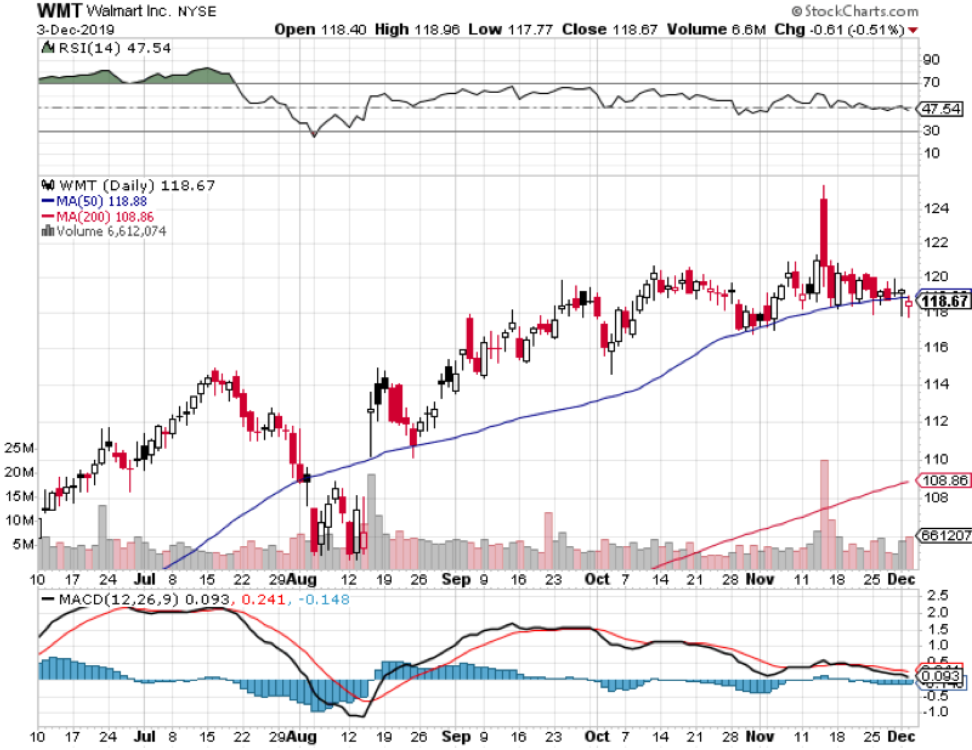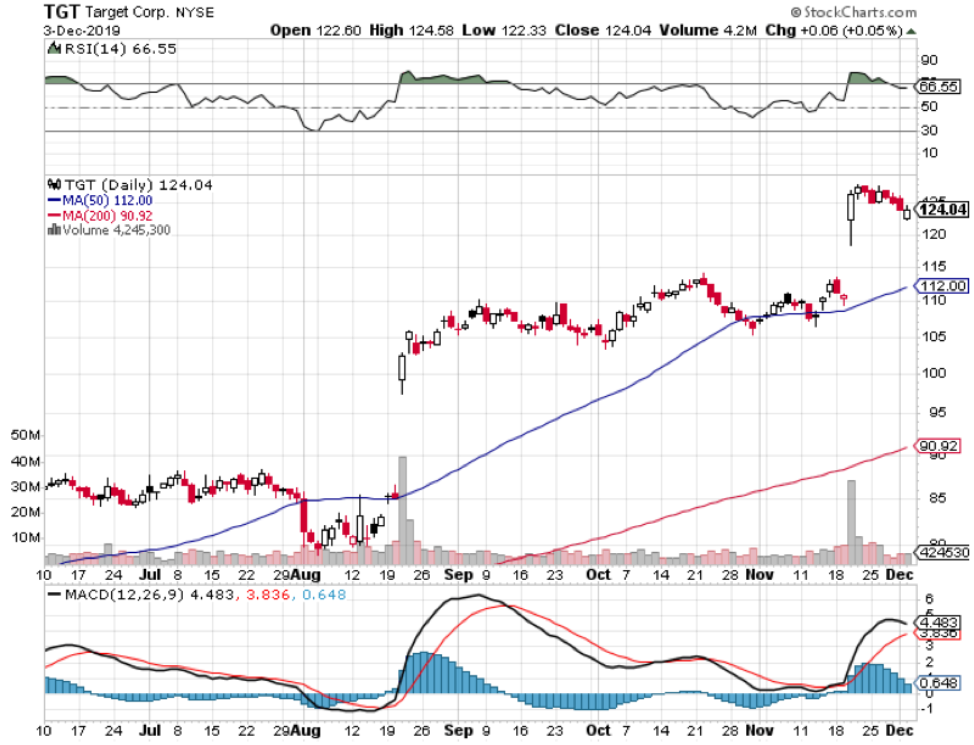Mad Hedge Technology Letter
December 4, 2019
Fiat Lux
Featured Trade:
(THE RUSH TO BUY ONLINE),
(AMZN), (WMT), (TGT), (W), (ETSY), (SHOP), (ADOBE)

Mad Hedge Technology Letter
December 4, 2019
Fiat Lux
Featured Trade:
(THE RUSH TO BUY ONLINE),
(AMZN), (WMT), (TGT), (W), (ETSY), (SHOP), (ADOBE)

There are several overarching seminal tech trends that I swear by.
The generational broad-based migration from analog to digital is a critical foundation that underpins the success of not only tech stocks as a unified sector, but the outperformance of the Mad Hedge Technology Letter.
You’ll be pleased to discover that 2019 is right on queue with digital sales exploding by the American consumer over the holiday shopping period and Americans ditching brick and mortar stores in droves.
Amazon (AMZN) broke records on Cyber Monday bragging that in terms of the number of items sold, it had its "single biggest shopping day."
Black Friday was a big success too selling “hundreds of millions" of products between Thanksgiving and Cyber Monday.
Consumers scooped up the toys, home, fashion and health, and personal care products on Amazon’s e-commerce platform.
Hot ticket items on Black Friday included Amazon's own Echo Dot and Fire TV Stick with Alexa Voice Remote, Play-Doh Sweet Shoppe Cookie Creations, Keurig K-Cafe Coffee Maker and LEGO City Ambulance Helicopter Kit.
Adobe (ADBE) Analytics estimates that the sales for the shopping bonanza easily eclipsed $29 billion, or 20% of total revenue for the full holiday season.
This is the aha moment when digital integration into shopping forced a paradigm shift to the business environment by capturing the focal point of American wallets.
Digital used to be the minority, but going forward, it will dictate the terms of engagement.
What does this mean in the bigger scope of things?
Mobile is the biggest winner of this brave new world.
Shopping apps gave consumers the platform to use their phones as a digital wallet.
Salesforce data discovered that Thanksgiving sales as a proportion of U.S. digital sales grew 17% and mobile sales rose 35% on Black Friday with 65% of total e-commerce executed through a mobile device.
“Black Friday broke mobile shopping records and even when shoppers went to stores, they were now buying nearly 41% more online before going to the store to pick up,” said Taylor Schreiner, principal analyst and head of Adobe Digital Insights.
Shopify (SHOP) did over $900 million in sales this year and 69% were from phones and only 31% from desktop computers.
Black Friday was "the biggest day ever for mobile," tracking $2.9 billion in sales from smartphones alone, or 39% of all e-commerce sales, a 21% increase year over year.
The data also showed that smaller e-commerce outfits had a harder time driving sales than large e-commerce platforms.
The network effect truly works both ways and the success of the biggest and best also correlated to a meaningful decline of physical shopping visit to stores of 6% on Black Friday.
According to The NPD Group's Holiday Purchase Intentions Survey, 20% of sales were picked up in the store. This click-and-collect business has been a huge winner for the likes of Walmart (WMT).
E-commerce leaders are having enormous success introducing omnichannel approaches to the selling channels.
The average order value on Black Friday rose 5.9% year over year to $168, a new record, in part because shoppers have become more comfortable buying expensive items online because the sales are even juicier.
Unfortunately, the rise in volume has meant lower margins.
Discounts averaged between 37% to 47% and home and consumer electronics products were popular.
With all the rumblings of tariff trauma and an approaching recession, the American consumer displayed robustness that largely met the consensus of analysts.
The takeaway is that e-commerce is as healthy as ever and should prolong not only the strength in e-commerce companies but the overall American economy.
The winners are the behemoths of Amazon, Target (TGT), Shopify, and Walmart. Shares should receive a moderate tailwind through the New Year.
Avoid smaller niche players like Etsy (ETSY) and Wayfair (W).



Legal Disclaimer
There is a very high degree of risk involved in trading. Past results are not indicative of future returns. MadHedgeFundTrader.com and all individuals affiliated with this site assume no responsibilities for your trading and investment results. The indicators, strategies, columns, articles and all other features are for educational purposes only and should not be construed as investment advice. Information for futures trading observations are obtained from sources believed to be reliable, but we do not warrant its completeness or accuracy, or warrant any results from the use of the information. Your use of the trading observations is entirely at your own risk and it is your sole responsibility to evaluate the accuracy, completeness and usefulness of the information. You must assess the risk of any trade with your broker and make your own independent decisions regarding any securities mentioned herein. Affiliates of MadHedgeFundTrader.com may have a position or effect transactions in the securities described herein (or options thereon) and/or otherwise employ trading strategies that may be consistent or inconsistent with the provided strategies.
This site uses cookies. By continuing to browse the site, you are agreeing to our use of cookies.
OKLearn moreWe may request cookies to be set on your device. We use cookies to let us know when you visit our websites, how you interact with us, to enrich your user experience, and to customize your relationship with our website.
Click on the different category headings to find out more. You can also change some of your preferences. Note that blocking some types of cookies may impact your experience on our websites and the services we are able to offer.
These cookies are strictly necessary to provide you with services available through our website and to use some of its features.
Because these cookies are strictly necessary to deliver the website, refuseing them will have impact how our site functions. You always can block or delete cookies by changing your browser settings and force blocking all cookies on this website. But this will always prompt you to accept/refuse cookies when revisiting our site.
We fully respect if you want to refuse cookies but to avoid asking you again and again kindly allow us to store a cookie for that. You are free to opt out any time or opt in for other cookies to get a better experience. If you refuse cookies we will remove all set cookies in our domain.
We provide you with a list of stored cookies on your computer in our domain so you can check what we stored. Due to security reasons we are not able to show or modify cookies from other domains. You can check these in your browser security settings.
These cookies collect information that is used either in aggregate form to help us understand how our website is being used or how effective our marketing campaigns are, or to help us customize our website and application for you in order to enhance your experience.
If you do not want that we track your visist to our site you can disable tracking in your browser here:
We also use different external services like Google Webfonts, Google Maps, and external Video providers. Since these providers may collect personal data like your IP address we allow you to block them here. Please be aware that this might heavily reduce the functionality and appearance of our site. Changes will take effect once you reload the page.
Google Webfont Settings:
Google Map Settings:
Vimeo and Youtube video embeds:
